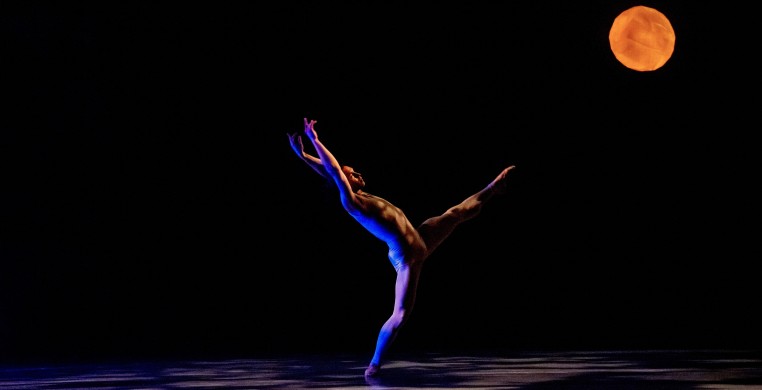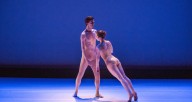For ten years Chicago Repertory Ballet (CRB) has made it a point to stand out from the traditional ballet crowd, choosing instead to approach the art form from a more contemporary perspective. CRB’s focus, according to the program, is on “breaking people’s preconceived notions of the art form and bringing ‘dance that defies labels’ to the stage.”
Wade Schaaf, who founded CRB in 2011 and serves as the artistic director, attended the performance in a stunning black corset, matching peach-colored chiffon skirt and pumps, adorned with earrings and a brassure made of long feathers and finished with a touch of red lipstick. In “10,” CRB lives up to its mission statement, breaking free from stuffy conventional notions of what ballet “is” while maintaining the integrity of the balletic form of clean lines, a deep adherence to the music and a make-it-look-easy athleticism.
The evening begins with “Birthday Fête,” a world premiere by Schaff set to Felix Mendelssohn’s “Piano Concerto No. 1.” Eight dancers are split up into solos, duos, trios and large groups that dart this way and that, in and out of the wings. Quick transitions from scene to scene made it feel like watching a movie trailer, where all the best scenes are quickly spliced together. Women, dressed in red leotards and skirts, and men, wearing fluffy white shirts atop grey tights, jauntily kick up their legs while spinning around each other, forming two large, concentric circles. Moving into three columns, they pose statuesquely, while a soloist completes a series of turns and leaps. A pas de deux nestled midway into the piece features Eliza Weekley, who gets spun around dizzyingly by Marco Clamente—at least, I’m pretty sure that this is the pas de deux mentioned in the program, as the action is so swift that it was not always clear to me exactly who I should be focusing on.
A video projected on the back wall includes a mélange of candid photos of CRB rehearsals interspersed with video samples from the company’s past repertoire and credits a long list of guest choreographers—all set to a happy and bouncing indie-pop music soundtrack. The tone of the video shifts midway and we are treated to longer samples, scenes from “Macbeth” and “Rite of Spring.”
A title card announces the next video, an excerpt from “The Four Seasons,” a 2014 piece by Schaaf set to a reworking of Vivaldi’s four famous violin concertos by composer Max Richter. The first concerto, titled “Spring,” shows the full company, made tiny by the camera’s bird’s eye view, spilling out and dotting the screen, with women in flower-print skirts and men in either turquoise or maroon jumpsuits, when suddenly…
The full company bursts onto the stage, matching the formation and garb of their on-screen counterparts. “Spring,” the first of the concertos, creates a mirror-like effect that I wish had continued a little longer, but was abruptly cut off as the real-life dancers do-si-do around each other, performing deep lunges that mimic the curling arpeggiations of the accompanying violins. Curved arms arch forward, palms up, then soften and become wispy. Multiple rows crisscross each other with long leaps that appear weightless. That is, until everyone collapses in a loud “flump” on the floor.
The pastoral music is replaced by dissonant strokes on the violin, signaling the coming of the next excerpt, “Winter.” Vivaldi wrote “Winter” in a standard 4/4 meter, but Richter reconfigures the well-known piece in an uneven 2-2-3 beat , a tricky substitution, but you wouldn’t know it by viewing the dancers. Their tight spacing and low and angular poses remain crisp and natural despite the odd meter of the music. With the company in the background, a “Winter Pas de Trois” finds Marco Clemente and Mickey Erickson bouncing Rachel Schmidt back and forth between them in a playful tug of war.
“Hunter’s Moon” by Mike Tyus begins with a dancer in the guise of a lycanthropic beast, crouched low under a glowing paper moon, gnawing on the body of her prey, wriggling and writhing while being consumed alive. As a blue fog rolls in, an entire pack of lycanthropes, wearing tan and brown nude leotards and tights, prowl the stage from left to right. Splashes of moonlight dot the floor as the pack moves silently along the forest floor, swooping their noses down and up, sniffing the air, smelling the recent kill. Soloist Akilah Harris, the prey that was being consumed, is miraculously alive. But at what cost? Tyus’ vivid storytelling combined with the athleticism of the dancers, and an exceptional lighting design by Margret Nelson, gives “Hunter’s Moon” layers of substance, something that you can really sink your teeth into.
“Transcending Quiet,” a world premiere pas de deux by Kia Smith, begins with dancer Mickey Erickson grabbing partner Rachel Shmidt by the waist, dancing her gently as if she were a marionette. He spins her around on one leg and tilts her side to side, against the sound of scratching violin strings, always following behind her a second later, like an after image. The two separate and explore on their own, but the recurring motif, a leap with windmill arms and legs that pedal midair, bring them back together for one last embrace. The softness of movement exhibited by Erickson and Shmidt and the intimacy of Smith’s choreography made for a nice middle ground between Schaaf’s bright exuberance and Tyus’ gore and gloom.
“Grand Pianola Music: On the Great Divide,” another high-energy production number by Schaaf, again displays the choreographer’s talent for lightning-fast transitions of different sized groups. Oscillating octaves ring out of the upper register of a piano as the curtain rises on dancers already in motion. As the music grows in intensity, wave after wave of dancers create one beautiful moment after another. A triangle-shaped trio leaps diagonally from front to back, then another one from the opposite side. A male dancer performs a string of long jetés in a wide circle. Another female dancer executes several fouetté turns, her right foot whisking the air with each rotation. The entire company assembles for one final centerpiece moment, with multiple layers of different poses making your eye leap from dancer to dancer, trying to catch every image before they can hold it no longer.
I must admit, I have never seen one of CRB’s full-length ballets, and that’s a shame, because I am interested to see the softer side of Schaaf, the one that I caught glimpses of in those fractional video clips from earlier.
This program was one of celebration and resilience, and it makes sense why the entire performance felt like fireworks on the Fourth of July. It also felt like a giant relief, like that sense of euphoria you feel after holding your breath for a long period, and then taking a giant, loud gulp of air. If that’s the case, then Schaaf and CRB can breathe a little easier now, their place in the annals of Chicago dance history secure and their future looking bright.


